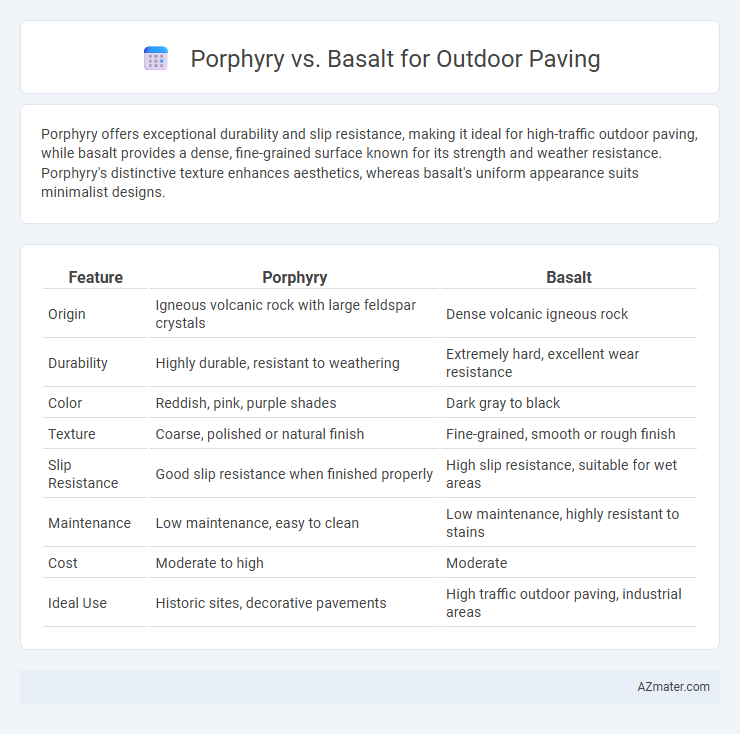Porphyry offers exceptional durability and slip resistance, making it ideal for high-traffic outdoor paving, while basalt provides a dense, fine-grained surface known for its strength and weather resistance. Porphyry's distinctive texture enhances aesthetics, whereas basalt's uniform appearance suits minimalist designs.
Table of Comparison
| Feature | Porphyry | Basalt |
|---|---|---|
| Origin | Igneous volcanic rock with large feldspar crystals | Dense volcanic igneous rock |
| Durability | Highly durable, resistant to weathering | Extremely hard, excellent wear resistance |
| Color | Reddish, pink, purple shades | Dark gray to black |
| Texture | Coarse, polished or natural finish | Fine-grained, smooth or rough finish |
| Slip Resistance | Good slip resistance when finished properly | High slip resistance, suitable for wet areas |
| Maintenance | Low maintenance, easy to clean | Low maintenance, highly resistant to stains |
| Cost | Moderate to high | Moderate |
| Ideal Use | Historic sites, decorative pavements | High traffic outdoor paving, industrial areas |
Introduction to Porphyry and Basalt for Outdoor Paving
Porphyry is a durable igneous rock characterized by its large-grained crystals embedded in a fine-grained matrix, making it highly resistant to wear and ideal for outdoor paving. Basalt, another igneous rock, is known for its dense, fine-grained texture and excellent hardness, offering excellent slip resistance and longevity in outdoor environments. Both materials provide robust solutions for outdoor paving, with porphyry favored for its aesthetic variation and basalt preferred for its uniformity and high compressive strength.
Geological Origins and Formation
Porphyry is an igneous rock characterized by large, well-formed crystals embedded in a fine-grained matrix, formed from slow cooling magma beneath the Earth's surface. Basalt, a fine-grained volcanic rock, originates from the rapid cooling of lava at or near the surface, resulting in a dense and durable texture ideal for outdoor paving. The geological origin of porphyry offers enhanced aesthetic appeal with its distinct crystal patterns, while basalt's volcanic formation provides exceptional strength and weather resistance.
Physical Properties and Appearance
Porphyry exhibits exceptional durability with high compressive strength and low water absorption, making it resistant to frost and wear for outdoor paving. Basalt provides a uniform dark gray to black appearance with fine grain texture and excellent slip resistance, ideal for modern aesthetics. Porphyry's rich reddish or pink hues and coarse-grained structure offer a distinctive, natural look compared to basalt's smooth, consistent color and finer grain size.
Slip Resistance and Safety
Porphyry offers superior slip resistance for outdoor paving due to its natural rough texture and high durability, making it ideal for wet or icy conditions to enhance safety. Basalt is also slip-resistant but tends to have a smoother finish, which can reduce traction and increase the risk of slipping in adverse weather. Choosing porphyry ensures better grip and longevity for outdoor surfaces, providing safer walkways and public spaces.
Durability and Weathering Resistance
Porphyry exhibits exceptional durability and superior weathering resistance, making it an ideal choice for outdoor paving in harsh climates. Its dense crystalline structure resists abrasion, freeze-thaw cycles, and chemical erosion better than basalt, which, while durable, is more porous and susceptible to weather-induced wear over time. Porphyry's long-lasting performance minimizes maintenance costs and retains aesthetic appeal in outdoor environments subject to heavy foot traffic and variable weather conditions.
Installation Methods and Techniques
Porphyry and basalt are popular choices for outdoor paving due to their durability and aesthetic appeal, yet their installation methods differ significantly. Porphyry paving requires dry-laid or mortar joint techniques to accommodate its irregular shape and natural cleft surface, ensuring stability and proper drainage. Basalt tiles often utilize a wet-set mortar bed installation for a flat, uniform surface, suitable for creating sleek, modern outdoor spaces with enhanced slip resistance.
Maintenance and Longevity
Porphyry offers exceptional durability and low maintenance, making it ideal for outdoor paving with high foot traffic, as its dense crystalline structure resists weathering and staining. Basalt, while also durable, may require more frequent sealing to maintain its appearance and protect against moisture penetration and erosion. Over time, porphyry's natural hardness ensures superior longevity, often surpassing basalt in maintaining structural integrity under varying environmental conditions.
Cost Comparison and Budget Considerations
Porphyry offers high durability and a premium look but comes at a higher initial cost, typically ranging from $15 to $30 per square foot, making it suitable for larger budgets focused on long-term investment. Basalt is more budget-friendly, with prices averaging $10 to $20 per square foot, providing a cost-effective solution while still delivering strength and weather resistance for outdoor paving projects. Budget considerations should weigh upfront material expenses against lifespan and maintenance needs, where porphyry may reduce replacement costs over time despite its steeper price.
Design Versatility and Aesthetic Appeal
Porphyry offers rich color variations and a textured surface that enhances outdoor paving with a natural, elegant aesthetic, making it ideal for upscale design projects requiring unique patterns. Basalt provides a sleek, uniform dark appearance and smooth finish, suited for modern minimalist styles demanding clean lines and subtle sophistication. Both stones deliver high durability, but porphyry excels in design versatility due to its diverse palette and natural veining.
Environmental Impact and Sustainability
Porphyry offers high durability and natural weather resistance, reducing the need for frequent replacements and minimizing environmental waste in outdoor paving projects. Basalt, known for its dense composition and long lifespan, also provides sustainable paving by limiting resource consumption and carbon footprint during manufacturing. Both materials contribute to eco-friendly landscaping by supporting low-impact extraction methods and promoting longevity, yet porphyry's lighter processing requirements often result in a marginally lower environmental impact.

Infographic: Porphyry vs Basalt for Outdoor Paving
 azmater.com
azmater.com